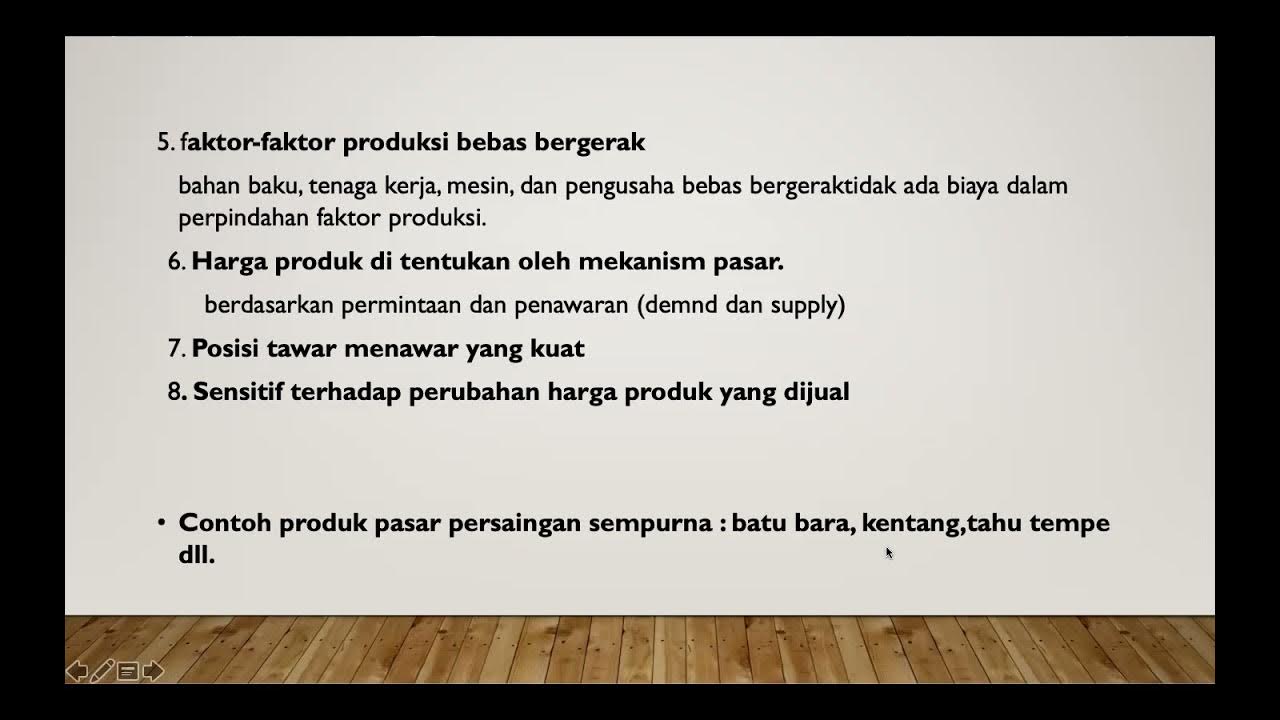Economics. S5: Market Structures
Summary
TLDRThis video script introduces the four main market structures in microeconomics: perfect competition, monopoly, monopolistic competition, and oligopoly. It explains the key characteristics of each structure, such as the number of firms, barriers to entry, and pricing power. The script also covers how firms in each market structure maximize profits and their efficiency levels, discussing concepts like allocative and productive efficiency. Additionally, it compares the short-run and long-run outcomes for firms in each structure, emphasizing the differences between competitive and monopolistic environments. The content concludes by briefly mentioning monopsony as another unique market structure.
Takeaways
- 😀 Perfect competition consists of many firms with identical products and no barriers to entry, ensuring price-taking behavior.
- 😀 In perfect competition, firms can only make normal profits in the long run due to the entry of new firms driven by supernormal profits in the short run.
- 😀 Monopoly market structure involves a single dominant firm with high barriers to entry, allowing it to make supernormal profits in both the short and long run.
- 😀 Monopolies are inefficient, as they do not achieve allocative or productive efficiency where marginal cost equals average cost.
- 😀 Monopolistic competition features many firms with differentiated products but no significant barriers to entry, resulting in normal profits in the long run.
- 😀 Oligopolies consist of a few large firms, often leading to interdependence where firms react to each other's actions, such as pricing and production decisions.
- 😀 Oligopolistic firms can sustain supernormal profits in the long run due to high barriers to entry.
- 😀 The kinked demand curve in oligopolies shows that firms face elastic demand when increasing prices and inelastic demand when decreasing prices, limiting their ability to change prices.
- 😀 In oligopoly markets, firms can maximize profits over a range of prices, rather than having a single profit-maximizing price point.
- 😀 Monopsony refers to a market structure with many suppliers but only one large buyer, giving the buyer market power to influence prices.
Q & A
What are the three main aspects to analyze when studying market structures?
-The three main aspects to analyze are the structure (the number of producers in the industry), the conduct (how firms behave to gain revenue and profits), and the performance (how effectively firms solve economic problems).
What is productive efficiency, and how is it achieved?
-Productive efficiency refers to firms minimizing their average costs, and it is achieved when marginal cost equals average cost (MC = AC). This point indicates that firms are using resources efficiently.
What is allocative efficiency, and how can it be determined in market structures?
-Allocative efficiency occurs when the price charged by firms equals the marginal cost of producing an additional unit (P = MC). This ensures that the price reflects the value to the consumer.
How does a perfect competition market structure operate?
-In a perfect competition market structure, there are many producers who are price takers. Products are homogeneous, and there are no barriers to entry. Firms can make supernormal profits in the short run, but competition will drive profits to normal levels in the long run.
What happens to firms in perfect competition in the long run?
-In the long run, firms in a perfect competition market structure will only make normal profits due to the lack of barriers to entry, which leads to new firms entering the market, increasing supply and driving down prices.
How are monopolies different from firms in perfect competition?
-Monopolies are single firms that control the entire market and are price makers. They face strong barriers to entry, which allow them to sustain supernormal profits in the long run, unlike firms in perfect competition which cannot sustain such profits due to easy entry of new firms.
What is the inefficiency in monopoly market structures?
-Monopoly firms are inefficient because they maximize profits before reaching the technical efficiency point (where MC = AC) and allocative efficiency point (where MC = AR). As a result, they do not strive to minimize costs and may charge higher prices.
What are the characteristics of a monopolistic competition market structure?
-In monopolistic competition, there are many firms, but fewer than in perfect competition. The firms use product differentiation to compete, and there are weak barriers to entry, meaning firms can only make supernormal profits in the short run, but not in the long run.
What is a key feature of oligopoly market structures?
-Oligopolies consist of a few large firms that dominate the market, and they exhibit interdependent behavior, meaning that firms take each other's actions into account when making pricing and output decisions. Price cartels and price wars are also common in oligopoly markets.
How does the kinked demand curve model explain pricing behavior in oligopolies?
-The kinked demand curve model suggests that oligopoly firms can sustain supernormal profits over a range of prices. If one firm lowers its price, others will follow, leading to inelastic demand for lower prices and elastic demand for higher prices. This creates price stability despite changes in costs.
Outlines

This section is available to paid users only. Please upgrade to access this part.
Upgrade NowMindmap

This section is available to paid users only. Please upgrade to access this part.
Upgrade NowKeywords

This section is available to paid users only. Please upgrade to access this part.
Upgrade NowHighlights

This section is available to paid users only. Please upgrade to access this part.
Upgrade NowTranscripts

This section is available to paid users only. Please upgrade to access this part.
Upgrade NowBrowse More Related Video

STRUKTUR PASAR (PASAR PERSAINGAN SEMPURNA, MONOPOLI, OLIGOPOLI, MONOPOLISTIK KELAS 10)

Estruturas de Mercado: Concorrência Perfeita, Monopólio e Oligopólio

STRUKTUR PASAR

Pasar Persaingan Sempurna, Pasar Monopoli, Pasar Oligopoli, Pasar Persaingan Monopolistik #pasar

PASAR: Struktur dan Bentuk-bentuknya

Episode 25: Market Structures
5.0 / 5 (0 votes)